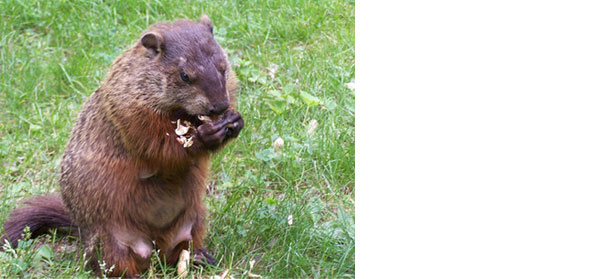

Apr 23, 2012How many veggies can a woodchuck chuck?
Woodchucks, also known as groundhogs, are large members of the rodent family and voracious herbivores that can do a lot of damage to crops.
Besides what they consume, their burrows can damage root systems. They mark their territory with scratching, chewing and urinating, said Stephen Vantassel, a wildlife control consultant with the University of Nebraska. In one study by the University of Connecticut, production of apples within 10 meters of a woodchuck den decreased by more than 30 percent, just from the woodchuck marking its territory.
Removal
Spring is the best time to remove damaging woodchuck populations, Vantassel said. Adult woodchucks are active, but young animals often stay in burrows during spring. The burrows are easier to find before annual vegetation conceals the entrances, and other wildlife is less likely to use the burrows as shelter then.
So, what are the best lethal methods? Rene Bollengier, a retired regional director with USDA’s Animal Damage Control, said shooting – where legal – works well, but is time consuming.
Shooting can be used to remove problem woodchucks from fields containing edible crops. However, it may be illegal or unsafe to shoot woodchucks in some circumstances. Preferred choices for shooting include rimfire cartridges such as the .22LR and the newer .17 HMR, as well as shotguns of just about any gauge, he said.
“If shooting can be accomplished safely, landowners and/or hunters can reduce or maintain a low population of woodchucks where necessary,” he said.
Like other wild animals, woodchucks can carry disease, Vantassel said. He suggests wearing gloves when handling woodchuck carcasses, since there is a chance of exposure to nervous system fluids and rabies, he said.
Trapping
Woodchucks can be captured using foot-hold traps, body grips or cage traps, baited and set near burrow entrances or directly over them, Vantassel said. Traps should be checked at least twice daily. Effective baits include the food types the woodchuck is feeding on, as well as soil from the burrow’s entrance that often contains pheromones attractive to the animal.
The most effective way to use a cage trap is to place it directly over the burrow hole and barricade it so that the only way out is through the trap.
“The only light he can see is coming through the trap,” Vantassel said. “That’s the most effective way to do it.”
For trapping to work, you have to commit to and stay with it.
“People hold trapping to an unfair standard that they don’t hold other techniques to,” Vantassel said. “For example, why is it that property owners will spray for bugs repeatedly throughout the year, every year, without thinking twice? Yet, if they have to trap for one week a year, the technique is declared to be a failure because it didn’t stop the wildlife damage for perpetuity.”
Vantassel also warned of some common misconceptions about trapping. Leg-hold traps are live traps. They allow you to release the animal basically unharmed. Cage traps can cause the animal to overheat and die from exposure if not checked regularly, or if they’re not shaded.
If you choose to release the animal, know the regulations. Most states consider relocation to mean within the animal’s home range – still on your property and close to the burrow. Translocation, or moving it away from its home area, is quite often illegal, he said.
Fumigants
Fumigant cartridges of sulphur/charcoal/sodium nitrate are effective against woodchucks, Vantassel said. He suggests taping the cartridge to a stick to keep it away from your body as you light it, as well as get it deeper into the burrow.
“It is also a good idea to fumigate in the early evening, when there is a better chance the woodchucks will be in the dens,” he said. “Woodchcucks also tend to prefer to den in looser, sandy soils, so it works well to fumigate after rain. The moist soil keeps the fumigant in the den longer and makes it that much more effective.”
Twenty-eight percent of the burrows fumigated during one study were reoccupied within two days, and 83 percent were reoccupied within two weeks after treatment, Bollengier said. The rapid reoccupation of burrows may have resulted because the treatment was applied during the day, when woodchucks are least likely to be inside burrows and because more than one animal might be using the burrow.
Exclusion
No products are currently registered with EPA for use as woodchuck repellents, Bollengier said. Modification of habitats in and around fields can help reduce their attractiveness and can increase the effectiveness of other control techniques.
Elimination of brush piles and overgrown areas will facilitate the discovery and treatment of burrows. Unfortunately, elimination of these areas may also eliminate valuable habitat for other wildlife. No research indicates supplemental plantings can draw woodchucks away from more valuable crops, he said.
Fencing can be effective at reducing woodchuck damage. Woodchucks may be excluded from small areas with a 4-foot-high fence whose bottom is buried 10 to 12 inches. Electric fences can work for smaller areas. When connected to a UL-approved fence charger, the electric fence will prevent climbing and burrowing. Bending the top 15 inches of wire fence outward at a 45-degree angle will also prevent climbing over the fence.
Fencing is useful in protecting crops and has the added advantage of keeping rabbits and other animals out of the area. In some instances, an electric fence placed 4 to 5 inches above the ground has deterred woodchucks from entering. Vegetation around any electric fence should be removed regularly to prevent the system from shorting out, according to Vantassel.
For more information, visit Vantassel’s website.
By Derrek Sigler, Assistant Editor














